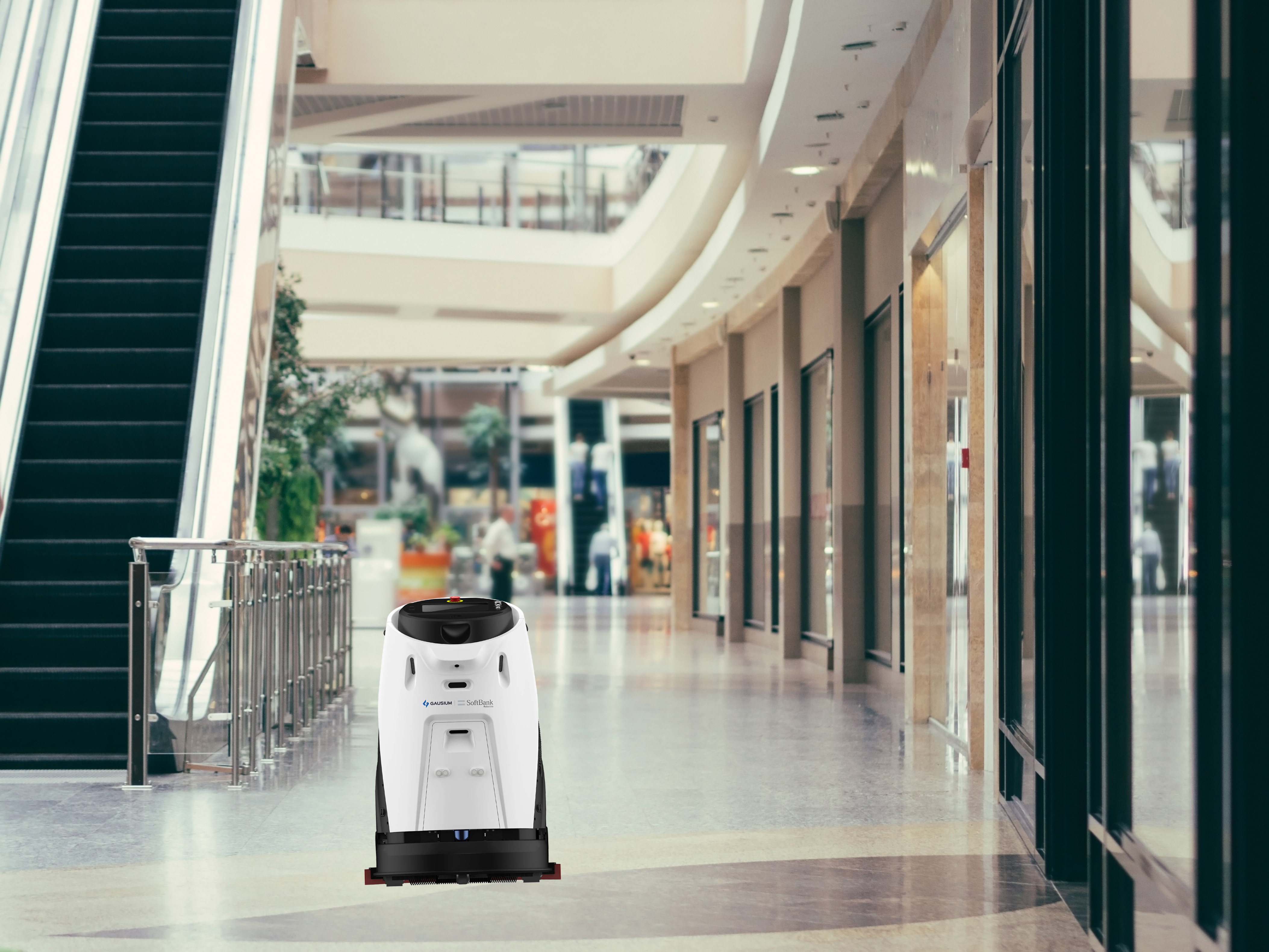Autonomous floor scrubbers can help commercial cleaning teams boost efficiency in a wide range of industries and cleaning applications. Many can even improve their performance over time.
In this article, we explain what these powerful cleaning solutions do, how they work, and whether they could be the right fit for your indoor commercial space.
What Is an Autonomous Floor Scrubber and What Does It Do?
In short, an autonomous floor scrubber is an automated cleaning solution designed to perform common commercial cleaning tasks for hard floor surfaces, including scrubbing, dust mopping and sweeping, all in the most efficient manner possible. An effective robotic floor scrubber should be able to reliably remove dust, grime, minor debris, scuffs, stains and spills.
Autonomous floor scrubbers are designed to efficiently clean with minimal human intervention, which makes them ideal for just about any hard-floored, high-traffic large indoor space with a need for constant cleaning. Today, many autonomous floor scrubbers can automatically avoid obstacles, including humans, allowing them to work safely in crowded, dynamic environments, without relying on strict pre-programmed routes. Shopping centers, office buildings, hotels, athletics venues, healthcare facilities, and educational institutions are just a few examples of common facilities that need to continuously be cleaned in the most efficient manner possible.
Many of these automated solutions can be deployed flexibly across a broad variety of facilities because of their ability to clean common commercial floor surfaces such as:
- Natural stone
- Artificial marble or granite
- PVC and vinyl flooring
- Epoxy surfaces
- Concrete
- Ceramic tile
Because they can apply water more precisely than a traditional bucket-and-mop system, robotic floor scrubbers can accommodate all of these surfaces while often saving water. As we explain below, this is just one of several ways that these autonomous systems can help reduce water usage.
How Autonomous Floor Scrubbers Work
Autonomous floor scrubbers employ different cleaning attachments enabling them to combine multiple cleaning tasks (such as scrubbing and dust mopping) in a single, integrated solution.
Most robotic floor scrubbers employ a multi-part system to complete cleaning tasks:
- An automated dispensing system for applying controlled quantities of water and/or cleaning solutions.
- A scrubbing system, which can be configured to use a floor pad, disc brush, or roller brush, cleans floors with power and precision that are almost impossible to achieve by hand.
- A combined squeegee and vacuum system for drying the floor, removing cleaning agents, and leaving behind a clean, safe space for customers. Dirty fluids, dust, and grime are stored in a tank within the floor scrubber until they are periodically emptied.
Using an array of sensors (including LiDAR, 3D, and RGP Cameras) supported by advanced AI algorithms, certain autonomous floor scrubbers like the Scrubber 50 Pro do not simply follow random or predetermined patterns, nor do they rely on close human supervision. Instead, they can proactively scan the area around them for new spills or other messes. These intelligent detection capabilities help floor scrubbers work more efficiently, focusing their efforts on the areas most in need of cleaning while avoiding unnecessarily repetitive cleansing of the same areas.
By learning the space around them, the areas most likely to need cleaning, and the most efficient routes through the space, autonomous floor scrubbers can actually improve their performance and efficiency over time.
How To Use an Autonomous Floor Scrubber
1. Prepare human staff to work with cobots.
An autonomous floor scrubber is an example of a cobot, a collaborative robot designed to work safely in the same space as humans. Some staff may be worried that they will be replaced by these automated solutions, but in fact, robotic scrubbers take on the most repetitive tasks, freeing up human staff to focus on more valuable and less monotonous work.
2. Prepare the area for a new autonomous floor scrubber.
In many cases, deploying an autonomous scrubber requires establishing a station for recharging the robot, emptying its waste tank, and refilling water. Autonomous scrubbers like the Scrubber 50 Pro even provide the option of an automated station that allows for these tasks to be performed without human assistance.
3. Deploy your new robotic floor scrubber.
With the area and staff prepared, the scrubber may be programmed to clean based on a predetermined schedule or task list or make dynamic operational decisions depending on factors such as urgent spills, charge level, and routing efficiency.
A robotic floor cleaner should be easy to set up and manage. The Scrubber 50 Pro, for example, can be controlled via a user-friendly display with an intuitive interface, making it easy to set up new machines and train new employees.
Deployment is also where partnering with a trusted robotics provider, like SoftBank Robotics, becomes critical. As part of our multi-layer service offerings, we support our customers’ deployment efforts by helping train employees, programming routes and maps, and providing ongoing operations support.
4. Allow your robotic floor scrubber to map the area.
Autonomous floor scrubbers can often efficiently map and determine cleaning paths for their assigned area. The Scrubber 50 Pro can map a 20,000 sq. ft. site in about 30 minutes. While AI helps avoid obstacles, virtual walls and avoidance areas can also be set manually to avoid damage.
5. Perform ongoing operations and maintenance.
With access to a charging station and a supply of water for filling and draining, certain autonomous floor scrubbers like the Scrubber 50 Pro can operate continuously for up to 3 hours at a time, learning as they clean.
Key Features To Consider in a Robotic Floor Scrubber
If you are considering a robotic floor scrubber, what are the most important features to consider? We recommend searching for a product with the capabilities outlined below. While a variety of automated solutions may be able to perform basic cleaning tasks, the right features can substantially boost ROI for your autonomous floor scrubbing system.
Efficient Cleaning for Large Areas
The more area that a floor scrubber is capable of efficiently cleaning, the more value it can provide. For example, the Scrubber 50 Pro can efficiently clean up to 12,000 sq. ft. per hour with its disc brush.
Built-In Filtration Systems to Save Water
A water recycling system is a unique capability that allows the machine to reuse water already in its tank, and therefore operate continuously for longer and with less human intervention. For example, the Scrubber 50 Pro features a unique built-in, 5-stage water recycling and filtration system that reduces freshwater consumption by around 75%.
Access to Real-Time, Actionable Data
Data-driven cleaning helps commercial cleaning organizations maximize their team’s efficiency, manage cleaning operations at scale, and stay afloat in the rising tide of customer expectations. By utilizing autonomous floor scrubbers that capture data while they clean, you’ll have increased visibility into what areas of your facilities have been cleaned, how often they are cleaned, and what routes your scrubbers take.
Sustainable Design
Because many autonomous floor scrubbers work so efficiently, they can be a great method for improving sustainability. But the sustainability benefits of an autonomous floor scrubber are only as good as its design. The Scrubber 50 Pro, for instance, employs long-lasting, readily recyclable materials, along with durable LFP batteries capable of lasting up to 2,000 cycles.
Is an Automated Floor Scrubber Right for You?
If you manage a commercial cleaning operation for a high-traffic space that needs to be continuously cleaned, automated floor scrubbers can deliver exceptional value by allowing human staff to focus on other higher-value tasks, all while improving sustainability and achieving a deeper clean.
An automated commercial cleaning system can be an excellent investment for a variety of cleaning operations teams. For example, The Scrubber 50 Pro provides operational benefits including:
- Water recycling filtration system that reduces up to 75% of freshwater usage and allows for longer continuous operation (up to 3 hours).
- The ability to autonomously clean (scrubbing or dry mopping) up to 12,000 sq. ft. per hour, with smart obstacle avoidance and rerouting capabilities.
- Flexible automation that is capable of cleaning unsupervised for long periods of time with minimum human intervention, while retaining the ability to be operated manually using an ergonomic handle.
What’s more, beyond these tangible benefits, a Scrubber 50 Pro makes a powerful statement to customers that a facility is taking a proactive, tech-forward approach to maintaining the cleanest, safest space possible.
Learn More
As discussed above, automated floor scrubbers provide multi-faceted benefits for commercial cleaning teams, with the ability to drive more efficient staff operations, more effective cleaning, and improved sustainability.
Ready to unlock the power of automated cleaning solutions? See what the Scrubber 50 Pro can do for your business or schedule a consultation with one of our automation experts.







